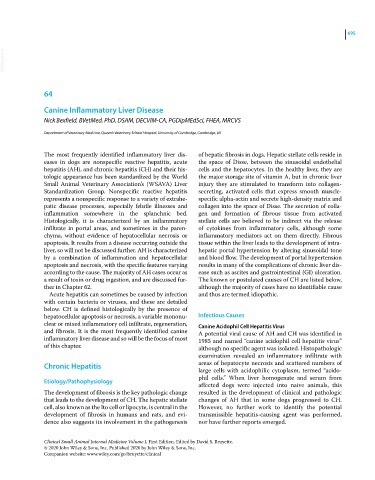Page 727 - Clinical Small Animal Internal Medicine
P. 727
695
VetBooks.ir
64
Canine Inflammatory Liver Disease
Nick Bexfield, BVetMed, PhD, DSAM, DECVIM-CA, PGDipMEdSci, FHEA, MRCVS
Department of Veterinary Medicine, Queen’s Veterinary School Hospital, University of Cambridge, Cambridge, UK
The most frequently identified inflammatory liver dis- of hepatic fibrosis in dogs. Hepatic stellate cells reside in
eases in dogs are nonspecific reactive hepatitis, acute the space of Disse, between the sinusoidal endothelial
hepatitis (AH), and chronic hepatitis (CH) and their his- cells and the hepatocytes. In the healthy liver, they are
tologic appearance has been standardized by the World the major storage site of vitamin A, but in chronic liver
Small Animal Veterinary Association’s (WSAVA) Liver injury they are stimulated to transform into collagen‐
Standardization Group. Nonspecific reactive hepatitis secreting, activated cells that express smooth muscle‐
represents a nonspecific response to a variety of extrahe- specific alpha‐actin and secrete high‐density matrix and
patic disease processes, especially febrile illnesses and collagen into the space of Disse. The secretion of colla-
inflammation somewhere in the splanchnic bed. gen and formation of fibrous tissue from activated
Histologically, it is characterized by an inflammatory stellate cells are believed to be indirect via the release
infiltrate in portal areas, and sometimes in the paren- of cytokines from inflammatory cells, although some
chyma, without evidence of hepatocellular necrosis or inflammatory mediators act on them directly. Fibrous
apoptosis. It results from a disease occurring outside the tissue within the liver leads to the development of intra-
liver, so will not be discussed further. AH is characterized hepatic portal hypertension by altering sinusoidal tone
by a combination of inflammation and hepatocellular and blood flow. The development of portal hypertension
apoptosis and necrosis, with the specific features varying results in many of the complications of chronic liver dis-
according to the cause. The majority of AH cases occur as ease such as ascites and gastrointestinal (GI) ulceration.
a result of toxin or drug ingestion, and are discussed fur- The known or postulated causes of CH are listed below,
ther in Chapter 62. although the majority of cases have no identifiable cause
Acute hepatitis can sometimes be caused by infection and thus are termed idiopathic.
with certain bacteria or viruses, and these are detailed
below. CH is defined histologically by the presence of
hepatocellular apoptosis or necrosis, a variable mononu- Infectious Causes
clear or mixed inflammatory cell infiltrate, regeneration, Canine Acidophil Cell Hepatitis Virus
and fibrosis. It is the most frequently identified canine A potential viral cause of AH and CH was identified in
inflammatory liver disease and so will be the focus of most 1985 and named “canine acidophil cell hepatitis virus”
of this chapter. although no specific agent was isolated. Histopathologic
examination revealed an inflammatory infiltrate with
Chronic Hepatitis areas of hepatocyte necrosis and scattered numbers of
large cells with acidophilic cytoplasm, termed “acido-
phil cells.” When liver homogenate and serum from
Etiology/Pathophysiology
affected dogs were injected into naive animals, this
The development of fibrosis is the key pathologic change resulted in the development of clinical and pathologic
that leads to the development of CH. The hepatic stellate changes of AH that in some dogs progressed to CH.
cell, also known as the Ito cell or lipocyte, is central in the However, no further work to identify the potential
development of fibrosis in humans and rats, and evi- transmissible hepatitis‐causing agent was performed,
dence also suggests its involvement in the pathogenesis nor have further reports emerged.
Clinical Small Animal Internal Medicine Volume I, First Edition. Edited by David S. Bruyette.
© 2020 John Wiley & Sons, Inc. Published 2020 by John Wiley & Sons, Inc.
Companion website: www.wiley.com/go/bruyette/clinical

